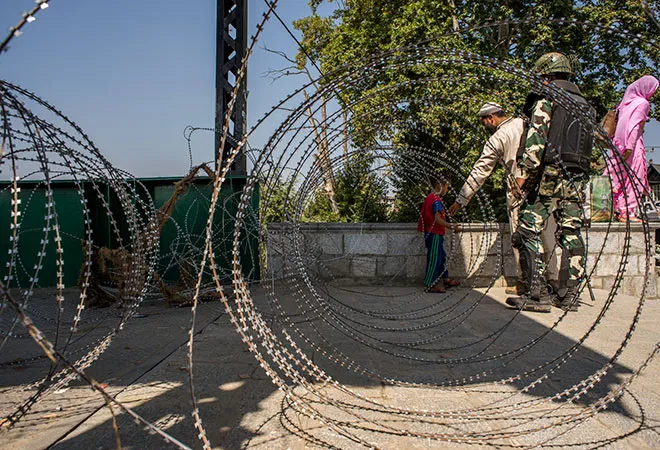
Kashmir is in a freeze. Sub-zero temperatures in the Valley has forced residents to remain confined in their homes and has reduced day to day activity to bare. 21st December marks the beginning of the Chillai Kalan – the coldest season of the year. Metaphorically, however, the harshest winter of Kashmir began on August 5th.
There was a near-total consensus among Kashmir observers that – the Valley would erupt and witness a spate of mass protests and violence awaits, in the aftermath of the constitutional changes announced by the Home Minister of India on the floor of the Parliament. But, instead of the expected spring of agitations and protests, an early winter descended on the region
The “civil curfew” that followed the government-imposed restrictions has continued in some shape or form to this date. People maintained bare minimum day to day activities for basic survival, during this shutdown. Barring a few hotspots, the intensity of protests and stone-pelting remained very low.
As far as the security situation goes, the forces have lost the dominance that they had on the counter-insurgency grid. An increase in infiltration across LoC after a brief lull (post-Balakot airstrike) suggests the new year may not bring a lot of cheer. As per reports, 55 terrorists have crossed LOC after 5 August and 114 in total this year.
After 5 August, the entire focus of security forces shifted to controlling law and order at the cost of suspension of counter-militancy operations for a considerable period. Statistics show that only 155 militants have been killed this year in comparison to 246 in 2018. Of all the militants killed this year, 120 were killed before 5 August.
The militant recruitment does not seem to be a very big concern. The Jammu and Kashmir police are claiming that there is no surge in recruitments since 5 August . Social media was an important tool to track the trends in recruitment, as new joiners would announce their bid through Telegram and WhatsApp groups. In the absence of such information, the trends in recruitment are difficult to quantify.
Pakistan’s tactical flip flops about its support to terror groups operating from its soil makes the situation even more uncertain. Recent public meetings of the top officials of Pakistan army with leaders of groups affiliated to Jaish-e-Mohammad suggest that the country is in no mood to retreat its support for cross border terrorism, this despite a court case against the Lashkar Chief Hafeez Saeed.
The security challenges will be as potent next year as they were before 5 August 2019 and the security agencies will have to go the extra mile to gain the upper hand in their counter-insurgency operations. At the same time, it will take a lot of effort to quell the geographical spread of militancy to the Jammu region. Kishtwar district of Jammu, which was militancy free until last year, has seen significant militant activity this year and this doesn’t bode well.
The worst outcome of the decisions taken on 5 August is the political vacuum and the suspension of all political activity in the Kashmir region. The detention of three former chief ministers and senior-most members of political parties has thrown the mainstream politics out of gear. Of the leaders released from detention, none has shown the courage to hold any political activity or issued political statements of any significance. Not much will change in the year 2020. The possibility of a political process in Kashmir will open only after the release of all senior mainstream leaders.
It is important to note that the mainstream political parties do not pose any grave security threat. As it is, there is very little possibility of any agitational mobilization in the sub-zero temperatures in winters. The detention of these leaders is more and more looking like a political vendetta. Security agencies are suggesting that the decision to release political detainees is in the hands of politicians, while the Home Minister has claimed that the decision on the political detainees in J&K lies with the local administration. Curiously, most of the separatist leaders are not under detention. If they didn’t pose any threat to law and order, then what special threat do mainstream leaders pose is a question begging for an answer. The government’s reasoning behind the detentions is paradoxical - on one hand the government claims these leaders have lost public support and on the other, they have been detained to maintain law and order on the grounds that they will rouse their supporters and create disturbances.
The top leadership of the government has made it clear that new political leadership will replace the old political elites. A lot of faces appeared on television screens claiming to be the next generation leaders of Kashmir. Off late, these names have disappeared from the TV screens. As it is, these new faces enjoy very little public support at the moment and to create a new political movement with these faces will take years.
Similarly, the Panchs and Sarpanches, the purported “new leaders” of Kashmir, have suddenly gone into silence too. Replacing old politicians with the panchayat leadership is a plan doomed to fail, as 62 percent of panchayat seats in the valley remain vacant. So, a fresh election of the vacant seats may be held next year. This brings in a rope of revival of politics in Kashmir but this exercise will succeed only if the old mainstream parties will contest the elections.
Similarly, the separatist politics will remain mostly suspended in 2020 owing to the fear of investigative agencies. The NIA cases against separatist leaders, many of whom are jailed, has acted as an effective deterrent against the Hurriyat. Even though NIA has not made any fresh arrests since August 5th, the pressure on Hurriyat will remain intact.
In all of this, the voice of the people of Kashmir remains unheard. The internet shutdown in the Kashmir which has continued for over 145 days has immeasurably disrupted the public discourse.
Whatever little information appears in the local and the national press is filtered. The local newspapers have imposed self-censorship and have avoided angering the government. Most of the reportage has focused on the restrictions, human rights situation and the government announcement.
However, not much is known about the grassroots public opinion regarding the decisions or how it will shape up. The silence maintained by the Kashmiri population and the leaders alike can in no way be taken as acceptance of the decisions taken on 5 August 2019.
There is a growing fear that the Spring season of 2020 may witness some unrest in the valley. While the fears of unrest are not unfounded, the massive fatigue factor may come to the rescue of the government. As per a trade body, the lockdown in Kashmir has inflicted a loss of $2.4 billion.
Since the unrest of 2016, the economy of the state, particularly the Kashmir region, has faced multiple disruptions and the overall economic situation remains in tatters. This may force an average Kashmiri to focus on the economic revival over agitations. The economic distress coupled with the fear of harsh crackdown might quell the possibility of an eruption.
The real consequences of the decisions taken on 5 August may not happen immediately. As history bears witness, Kashmir is prone to unpredictable twists and turns. The alienation of Kashmiris is much worse than that caused by the rigged elections of 1987. There was a surface level of calmness in Kashmir even after that rigged election and government in power did function for a while before all hell broke loose in the winter of 1989.
After the unrest of 2010, normalcy returned to Kashmir: millions of tourists started visiting the place; the levels of violence dropped to the lowest ever in three decades and the election of 2014 was perhaps the biggest signifier of the return of normalcy and peace. Needless to say that the events that unfolded in the year 2016 came as a rude shock to everyone that everything in Kashmir seems hunky-dory till the next eruption.
For now, the government of India will continue its policy on Kashmir. The contours of that policy are not very clear. So far, all the promises of developing Kashmir into a modern wonderland appear bleak. Ridding the place of terrorism and violence also appears a distant goal; so is the plan of creating a new crop of politicians. The new normalcy is anything but silence, quite similar to that of graveyards. Whether the new year will bring in hope – of peace, prosperity, and progress – is difficult to predict. But, one aspect of New Delhi’s policy on Kashmir is clear as crystal: it will appear tough, will not budge on anything – which will only prolong the winter in 2020.
The views expressed above belong to the author(s). ORF research and analyses now available on Telegram! Click here to access our curated content — blogs, longforms and interviews.




 PREV
PREV


